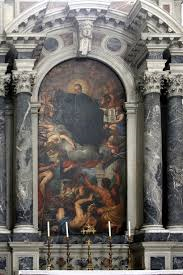AMONG the several noblemen who placed their sons under the care of St. Benedict, to be brought up in piety and learning, Equitius, one of that rank, left with him his son Maurus, then but twelve years old, in 522. The youth surpassed all his fellow monks in the discharge of monastic duties, and when he was grown up, St. Benedict made him his coadjutor in the government of Sublaco. Maurus, by his singleness of heart and profound humility, was a model of perfection to all the brethren, and was favored by God with the gift of miracles. St. Placidus, a fellow monk, the son of the senator Tertullus, going one day to fetch water, fell into the lake, and was carried the distance of a bow-shot from the bank. St. Benedict saw this in spirit in his cell, and bid Maurus run and draw him out. Maurus obeyed, walked upon the waters without perceiving it, and dragged out Placidus by the hair, without sinking in the least himself. He attributed the miracle to the prayers of St. Benedict; but the holy abbot, to the obedience of the disciple. Soon after that holy patriarch had retired to Cassino, he called St. Maurus thither, in the year 528. Thus far St. Gregory, Dia1.1. 2, c. 3, 4, 6.

St. Maurus coming to France in 543, founded, by the liberality of king Theodebert, the great abbey of Glanfeuil, now called St. Maur-sur-Loire, which he governed several years. In 581 he resigned the abbacy to Bertulf, and passed the remainder of his life in close solitude, in the uninterrupted contemplation of heavenly things, in order to prepare himself for his passage to eternity. After two years thus employed, he fell sick of a fever, with a pain in his side: he received the sacraments of the church, lying on sackcloth before the altar of St. Martin, and in the same posture expired on the 15th of January, in the year 584. He was buried on the right side of the altar in the same church,1 and on a roll of parchment laid in his tomb was inscribed this epitaph: “Maurus, a monk and deacon, who came into France in the days of king Theodebert, and died the eighteenth day before the month of February.”* St. Maurus is named in the ancient French litany composed by Alcuin, and in the Martyrologies of Florus, Usuard, and others. For fear of the Normans, in the ninth century, his body was translated to several places; lastly, in 868, to St. Peter’s des Fosses, then a Benedictir abbey, near Paris,2 where it was received with great solemnity by Æneas, bishop of Paris. A history of this translation, written by Eudo, at that time abbot of St. Peter’s des Fosses, is still extant. This abbey des Fosses was founded by Blidegisilus, deacon of the church of Paris, in the time of king Clovis II. and of Audebert, bishop of Paris: St. Babolen was the first abbot. This monastery was reformed by St. Mayeul, abbot of Cluni, in 988: in 1533 it was secularized by Clement VII. at the request of Francis I., and the deanery united to the bishopric of Paris; but the church and village have for several ages borne the name of St. Maur. The abbey of Glanfeuil, now called St. Maur-sur-Loire, was subjected to this des Fosses from the reign of Charles the Bald to the year 1096, in which Urban II., at the solicitation of the count of Anjou, re-established its primitive independence. Our ancestors had a particular veneration for St. Maurus, under the Norman kings; and the noble family of Seymour (from the French Saint Maur) borrow from him its name, as Camden observes in his Remains. The church of St. Peter’s des Fosses, two leagues from Paris, now called St. Maurus’s, was secularized, and made a collegiate, in 1533; and the canons removed to St. Louis, formerly called St. Thomas of Canterbury’s, at the Louvre in Paris, in 1750. The same year the relics of St. Maurus were translated thence to the abbey of St. Germain-des-Prez, where they are preserved in a rich shrine.3 An arm of this saint was with great devotion translated to mount Cassino, in the eleventh century,4 and by its touch a demoniac was afterwards delivered, as is related by Desiderius, at that time abbot of mount Cassin0,5 who was afterwards pope, under the name of Victor III. See Mabill. Annal. Bened. t. 1, 1. 3 and 4; and the genuine history of the translation of the body of St. Maurus to the monastery des Fosses, by Eudo, at that time abbot of this house. The life of St. Maurus, and history of his translation, under the pretended name of Faustus, is demonstrated by Cointe and others to be a notorious forgery, with several instruments beonging to the same.

No comments:
Post a Comment
Comments are subject to deletion if they are not germane. I have no problem with a bit of colourful language, but blasphemy or depraved profanity will not be allowed. Attacks on the Catholic Faith will not be tolerated. Comments will be deleted that are republican (Yanks! Note the lower case 'r'!), attacks on the legitimacy of Pope Francis as the Vicar of Christ (I know he's a material heretic and a Protector of Perverts, and I definitely want him gone yesterday! However, he is Pope, and I pray for him every day.), the legitimacy of the House of Windsor or of the claims of the Elder Line of the House of France, or attacks on the legitimacy of any of the currently ruling Houses of Europe.